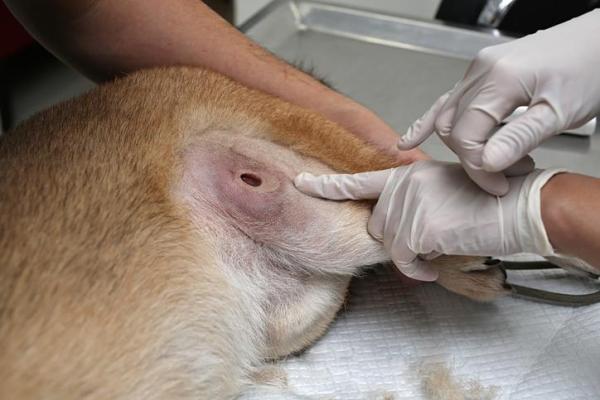
Clindamycin is an antibiotic which is becoming increasingly common in veterinary medicine. It is used most commonly for wounds and deep infections, whether they affect the skin, mouth and teeth. It can even be used to treat bone infections in dogs. However, before we reveal more, it is important to point out that any antibiotic treatment for dogs should only be carried out by a qualified veterinarian.
In this AnimalWised article, we look at clindamycin for dogs with skin, eye and teeth infections. We discover what is the best way to administer the drug, what dosage a dog may require and whether there are any side effects we need to be concerned about.
What is clindamycin?
Clindamycin is a bacteriostatic antibiotic that belongs to the class of antibiotics known as lincosamides. It works by inhibiting protein synthesis. Clindamycin has been found to be effective effective against the following bacteria:
- Staphylococcus aureus
- Staphylococcus pseudointermedius
- Streptococcus spp.
- Bacteroides spp.
- Clostridium perfringens
- Fusobacterium necrophorum
Clindamycin has also been found to register activity against Toxoplasma gondii. This is a type of parasitic protozoa which can cause serious health problems in the host dog.
Clindamycin is almost completely absorbed after oral administration and is eliminated in the faeces and urine. Administration is only carried out after diagnosis. Ideally, the bacteria should be cultured and analyzed in a laboratory for the specific bacteria. However, clindamycin can also be prescribed without it by experienced veterinarians.
Although clindamycin is a drug that is also used in human medicine, it has is marketed for dogs. It is specifically formulated for each animal and exclusively for veterinary use. Dogs can not use clindamycin used in human medicine and vice versa. The drug is usually prescription only and is available in various preparations including capsules, oral suspensions, topical creams and solution for injections.
Uses of clindamycin for dogs
As we state, the antibiotic clindamycin is most commonly used for skin, teeth and bone infections. The latter of which is not as common, but as clindamycin is a strong antibiotic, it can penetrate into deep tissue and even bones for an effective removal of bacteria.
The main uses of clindamycin in dogs are:
- Infected wounds on skin
- Other skin infections
- Abscesses on skin
- Dental abscesses
- Mouth infections
- Osteomyelitis (type of bone infection)
Clindamycin also improves the clinical signs triggered by active Toxoplasma gondii infection and can be used in respiratory, genitourinary, gastrointestinal or neosporosis infections. Although clindamycin can be used for treatment in dogs, not all human medicines can.

Dosage of clindamycin for dogs
Firstly, it is vital we point out that the dosage of clindamycin for dogs needs to be determined by a veterinarian. They are the only professionals who are able to determine whether clindamycin is suitable for a given infection and will provide all the details for its administration. It is essential we follow the specific guidelines for the dosage, as well as frequency and time of administration.
The dosage of clindamycin will depend on the dog, most specifically its weight. However, it will also depend on the type preparation and purpose of administration. Below we highlight an example of clindamycin dosage for dogs by looking at use of an oral suspension of the antibiotic:
- Infected wound: 2.5 - 15 mg/lb of body weight every 12 hours.
- Abscess: 2.5 - 15 mg/lb of body weight every 12 hours.
- Dental infections: 2.5 - 15 mg/lb of body weight every 12 hours.
- Osteomyelitis (bone infection): 5.0 - 15 mg/lb of body weight every 12 hours.
This will equate to between 1 and 6 ml of oral solution per 10 lbs of the dog's body weight. However, these may change if administered in a different preparation.
When no response is seen after a few days, the veterinarian will need to be informed in case there is an issue with the administration. Generally, it is not administered for more than 28 days. It is vital we carry out the full prescription dictated by the veterinarian, even if we think the infection has been cleared up. If we don't, it is more likely the infection will return and we run the risk of building up bacterial resistance to the drug.
Contraindications of clindamycin for dogs
In dehydrated dogs or those with serious kidney or liver problems, clindamycin can be used, but with strict control of doses and monitoring. In the case of pregnant or lactating female dogs, there is insufficient data to support its safety, although no harmful effects on fetuses have been reported in studies.
Regardless, it is up to the veterinarian whether clindamycin is prescribed. This will be done after assessing the risks and benefits of antibiotic treatment. It is known that clindamycin is present in a lactating dog's milk. For this reason, it is possible it will reach suckling puppies and can result in diarrhea for the newborns.
Clindamycin is not recommended for dogs that have previously exhibited hypersensitivity to the drug. If the dog is taking any other drugs, especially other antibiotics, it is vital we inform the veterinarian. This is in case there are any interactions which could affect its effectiveness or cause negative side effects.

Side effects of clindamycin for dogs
Typically, clindamycin does not cause any side effects. However, symptomsrelated to the digestive system have been seen. This include vomiting, diarrhea or anorexia, especially in prolonged treatments. We should bear in mind that the use of this medicine could favor the growth of certain bacteria which are not sensitive to it. The result is a potential superinfection which will also need to be treated by the veterinarian.
If the administration exceeds the recommended dose, an overdose may occur. This will cause symptoms such as vomiting, anorexia, diarrhea or an increase in liver enzymes. It is necessary to suspend the treatment and contact the veterinarian to treat the clinical signs that the dog shows. They will be able to determine the correct course of treatment and may need to intervene with emergency veterinary care.
Finally, when treatment with clindamycin lasts for a month or longer, it is necessary to carry out an analytical control. This is a test which checks the function of the dog's bodily systems, especially to check the functioning of the kidneys and liver. In these long treatments, clindamycin can be used together with probiotics to continue fighting the bacterial infection.
This article is purely informative. AnimalWised does not have the authority to prescribe any veterinary treatment or create a diagnosis. We invite you to take your pet to the veterinarian if they are suffering from any condition or pain.
If you want to read similar articles to Clindamycin For Dogs With Skin, Teeth and Bone Infections, we recommend you visit our Medicine category.
- Medivet. (n.d.). ClinDrops (Clindamycin Hydrochloride) For Dogs & Cats, 25mg/ml, 20 ml.
https://www.medi-vet.com/ClinDrops-Clindamycin-For-Dogs-Cats-p/18200.htm